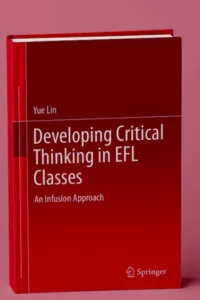The Developing Critical Thinking in EFL Classes book exhibits a creative instructing test and a diagnostic investigation of basic reasoning. You are going to learn a lot from it.
Developing Critical Thinking in EFL Classes
This book presents an innovative teaching experiment and an analytical study of critical thinking and the sociocultural theory of learning to illustrate the cognitive learning development mechanisms.
It addresses the issues in developing critical thinking, including the controversy surrounding the definition, measurement, and teaching of critical thinking, particularly in the L2 context.
The book explains how infusion-thinking lessons can be structured to help students develop critical thinking along with language learning.
Further, it uses a case study as a real-world example to examine the applicability and feasibility of infusion-thinking lessons in the EFL context and their effectiveness in developing students’ critical thinking and language learning.
Packed with thinking activities and techniques, this practical, hands-on manual provides original ideas and empirical data, giving teachers everything they need to plan their lessons to improve students’ critical thinking within language courses and evaluate their teaching.
About The Book
Previous research has indicated that the teaching of thinking skills has a positive influence on students’ achievements and attitudes in the L1 context, and recent trends in L2 teaching have also highlighted the importance of promoting thinking skills, especially critical thinking.
However, there is some controversy surrounding the applicability of teaching thinking skills in an L2 context, especially in an Asian ESL context. The intention of the study presented in this book was to investigate whether or not an infusion approach is applicable and helpful as a method of teaching thinking in a subject class.
Two classes of students from the same high school participated in the study; one received infusion lessons, and the other received traditional teaching by the same teacher.
Data were collected from Chinese versions of the California Critical Thinking measurements and students’ compositions in both pre- and post-intervention stages, and from self-evaluation questionnaires after the lessons in weeks one, four, seven and ten, as well as from post-intervention questionnaires and interviews conducted after the intervention.
The results of the study contradict the claims of some scholars (Atkinson 1997; Fox 1994) who are hesitant about introducing critical thinking into Asian L2 classrooms, revealing the applicability and positive effects of teaching critical thinking in L2 classes on critical thinking and L2 writing.
The thinking tasks in the lessons created a context conducive to critical thinking, which at the same time gave rise to opportunities for the students to create meaning in the target language.
The students took advantage of the opportunities to practise critical thinking in their writing, which in turn influenced the content and their use of language in their written texts.
The students demonstrated positive attitudes towards the lessons. The results indicate that the infusion approach is an applicable and helpful teaching method for integrating critical thinking into an L2 class.
This study contributes particularly to the idea of pedagogy that critical thinking skills can be integrated into L2 teaching, and that this has positive effects on students’ thinking and language learning.
In the area of research methodology, the results of this study showed that the Chinese versions of the CCTDI and CCTST can be used to assess students’ critical thinking at high school level; however, it was found that high school students need more time to complete these tests: 5 and 10 extra minutes for each test, respectively.
The findings also provided data to establish a norm for the CCTST for Chinese high school students.


